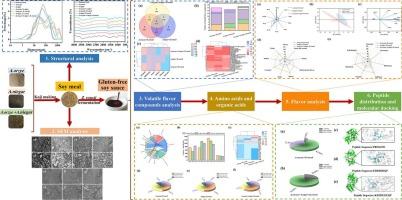Flavor profile and peptide formation in soy sauce fermented from soybean meal by Aspergillus oryzae and Aspergillus Niger
IF 9.8
1区 农林科学
Q1 CHEMISTRY, APPLIED
引用次数: 0
Abstract
To provide a novel strategy for the development of soy sauce with an improved flavor profile but without gluten, soybean meal was employed as the sole material for fermentation by Aspergillus niger and Aspergillus oryzae. SEM, FTIR, GC–MS, peptide omics and molecular docking were used to analyze flavor characteristics and flavor peptide formation in different combinations. The Aspergillus niger and Aspergillus oryzae groups stand out and presented 3.62-fold increases in alcohol, phenol, and ketone contents in soy sauce compared with Aspergillus oryzae alone; the contents of umami and sweet free amino acids increased by 12.66 %, with the highest content compared with Aspergillus niger; furthermore, Aspergillus niger promoted a 173.7 % increase in the Pro content of the soy sauce compared with Aspergillus oryzae alone, which influenced the amino acid distribution and overall flavor. Thus, the cofermentation of Aspergillus niger and Aspergillus oryzae provides an option for the development of soy sauce.

米曲霉和黑曲霉发酵豆粕酱油的风味特征和肽的形成
以豆粕为唯一原料,采用黑曲霉和米曲霉进行发酵,为开发无麸质、风味更好的酱油提供新思路。利用扫描电镜(SEM)、红外光谱(FTIR)、气相色谱-质谱(GC-MS)、肽组学(peptide omics)和分子对接等方法分析不同组合下风味特征及风味肽的形成。黑曲霉和米曲霉组在酱油中的醇、酚、酮含量比单独的米曲霉组高3.62倍;鲜味和甜味游离氨基酸含量提高了12.66 %,与黑曲霉相比含量最高;与单独添加米曲霉相比,黑曲霉可使酱油的Pro含量提高173.7 %,从而影响酱油的氨基酸分布和整体风味。因此,黑曲霉和米曲霉的共发酵为酱油的开发提供了一种选择。
本文章由计算机程序翻译,如有差异,请以英文原文为准。
求助全文
约1分钟内获得全文
求助全文
来源期刊

Food Chemistry
工程技术-食品科技
CiteScore
16.30
自引率
10.20%
发文量
3130
审稿时长
122 days
期刊介绍:
Food Chemistry publishes original research papers dealing with the advancement of the chemistry and biochemistry of foods or the analytical methods/ approach used. All papers should focus on the novelty of the research carried out.
 求助内容:
求助内容: 应助结果提醒方式:
应助结果提醒方式:


